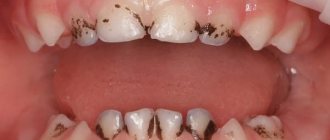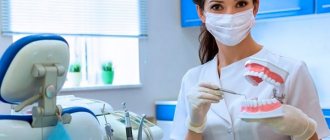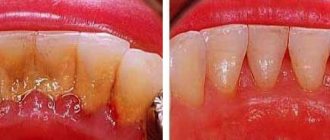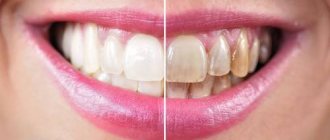As a result of constant tobacco abuse, a smoker's plaque forms on the enamel. Dark deposits are clearly visible on the teeth, and what is most unpleasant is that it is impossible to get rid of them using a regular brush and paste.
There are two types of dental deposits: soft and hard (tartar). To one degree or another, they can be present on the teeth of all people. But it is in smokers that this is most noticeable. The bright color of a smoker's plaque is explained by the fact that when inhaling cigarette smoke, nicotine, tar, phenolic and ammonia compounds enter the oral cavity. They tend to settle on the enamel, thereby staining it. Only professional products can eliminate persistent pigmentation.
How does smoking affect teeth?
Smoking is a bad habit that negatively affects the overall condition of the oral cavity and dental health. When regularly exposed to tobacco smoke, they acquire a yellow coating and look unattractive. The reason for this is the harmful substances that are part of the smoke - ammonia, tar, nicotine, tar, phenol-formaldehyde, etc. There are about 3,000 substances in total, some of which settle on the enamel and form a characteristic plaque from cigarettes.
Smokers who take good care of their mouths and brush their teeth thoroughly have little plaque buildup. But they also cannot get rid of old deposits that form in hard-to-reach places. Sooner or later, they cease to be just a cosmetic problem and become the cause of dental pathologies.
Absolutely every smoker experiences xerostomia - a kind of dry mouth, indicating an insufficient amount of saliva, which causes a disruption in the natural protective functions of the oral cavity. The result is that plaque very quickly forms on the surface of the teeth, which serves as a breeding ground for pathogenic microorganisms, the waste products of which provoke the appearance of caries and gingivitis.
If a person cannot give up his addiction, then he should regularly remove the plaque that has formed on his teeth from smoking. Otherwise, the development of complications cannot be avoided.
Teeth after cigarettes: what affects their condition
Considering the issues of dental problems in general, it can be affirmatively noted that the mucous membrane of the mouth, gums and teeth of a smoker are at risk to a significantly greater extent than those of an ordinary person.
First of all, the danger is associated with the presence of tar, nicotine, carbon monoxide, hydrocyanic acids, methane and combustion products in cigarette smoke, as well as the high temperature of the smoke, which provides a sharp temperature difference in the oral cavity. The effect of temperature changes is especially noticeable in the winter, when a person takes heated tobacco smoke into his mouth and immediately after that inhales cooled air from the environment.
With insufficient mineralization of tooth enamel, the temperature difference between inhaled smoke and air can cause the formation of microcracks, which in the process of their development destroy the natural structure of the tooth and provoke the development of various pathologies.
Signs of a smoker's plaque
Signs of this unpleasant phenomenon are visible to the naked eye. If desired, every smoker can detect them. To do this, just carefully examine your mouth and teeth in front of the mirror. In this case, the following symptoms of the problem may be observed.
- Visible change in enamel color towards darkening.
- The presence of yellow, brown or black plaque on the neck of the tooth (at the base) or on the inside of the dentition.
- Uncharacteristic color of gums, which look a little “overdried.”
After detecting these signs, all that remains is to exhale sharply into your palm to feel the bad breath - the eternal companion of heavy smokers.
The presence of one or more signs of cigarette plaque is a serious reason to contact specialized specialists - dentists.
Preventing yellow teeth from smoking
Prevention is classic and differs little from traditional oral care. Dentists recommend that smokers give up cigarettes, hookahs or vapes, and also adhere to daily oral care - brushing your teeth 2 times a day.
If the color of the enamel changes, it is necessary to undergo professional teeth cleaning, at least 1-2 times every six months, and also be regularly examined by a dentist.
Do you want to know more information about the dangers of smoking for your teeth or do you need professional help? Contact the specialists of the AlfaDent dental clinic in Orenburg and receive detailed advice from a specialized specialist!
Professional teeth cleaning from plaque
At the Dental Center on Shabolovka, professional teeth cleaning is carried out to effectively remove smoker’s plaque. To do this, one of the modern methods of teeth cleaning can be used.
- Mechanical cleaning
- the procedure is carried out manually, using ultrasound or Air-Flow and is reduced to the mechanical destruction of plaque and stone. - Chemical cleaning
is a procedure that involves the application of special dental solutions that soften and break down plaque and tartar, allowing them to be removed from the surface of the teeth. - A combined method
is a procedure that includes chemical and mechanical cleaning of teeth, thanks to which you can achieve the best visible result.
Once the smoker's plaque has been removed, the dentist will grind and polish the surface of the teeth, which will significantly reduce the rate at which the problem reappears.
Important to remember!
The popular teeth whitening procedure is carried out only after professional cleaning.
How to remove cigarette plaque on teeth: clinical methods
There are several effective ways to completely remove plaque formed as a result of smoking.
The first option is professional cleaning. It can be carried out using an AirFlow device, which supplies a solution with crushed abrasives under pressure. You can also remove stones and plaque using ultrasound. In addition, plaque is removed manually using special instruments - scalers and curettes.
The second option is chemical bleaching. It is carried out after cleaning and is a purely cosmetic procedure, since it does not provide any benefits to dental health, but after a few sessions you can get a radiant white smile. Chemical whitening involves applying specialized gels based on hydrogen peroxide. The gel is applied for half an hour or more, in addition, its action can be activated by a laser or light from a halogen lamp (photobleaching).
After you have cleaned your teeth of plaque, you need to take good care of them. Ideally, quit smoking altogether or at least reduce the number of cigarettes. Remember to brush your teeth thoroughly and regularly, eat less coloring products, and use specialized toothpastes.
Removing smoker's plaque at home
Most smokers are confident that they can get rid of yellow plaque on their teeth without visiting a dentist. To do this, it is enough to purchase one of the “newfangled” whitening products or a special toothpaste. At the same time, they completely do not take into account the peculiarities of the use of these funds and their conditionally positive effect.
The problem is that all home teeth whitening products are effective only in cases of minor plaque and have no effect on old deposits, especially if they are located in hard-to-reach places. Ideally, they should be used after professional cleaning to maintain the achieved result. This must be done with great care, since the active components and abrasive substances they contain have a destructive effect on tooth enamel.
Removing dental plaque at the dentist -
Depending on the amount of plaque and tartar, as well as the equipment of the dental office, the dentist can use the following methods or a combination of them:
- ultrasonic cleaning + conventional mechanical polishing (carried out using a polishing brush and paste),
- ultrasonic cleaning + Air-Flow,
- Air-Flow only.
a) Cleaning dental plaque using Air Flow –
The Air-Flow method is something like sandblasting. From a special tip under high pressure, a water-air mixture with particles of an abrasive-polishing substance is supplied to the tooth surface. This method works great if your layer of pigmented plaque is not too thick and there are no massive hard dental deposits. But if they do exist, then the dentist will first remove the massive deposits with ultrasound and, using Air-flow, polish your teeth, removing all the smallest irregularities and plaque residues.
How to get rid of plaque using Air-flow –
b) Removal of dental plaque using ultrasound –
Ultrasound cleaning of plaque is the most common and most versatile method. Its advantage is that with the help of ultrasonic cleaning devices (scalers) you can remove pigmented plaque of any severity, as well as the most massive hard dental deposits. The cost of the procedure averages from 150 to 200 rubles per 1 tooth, but there are clinics where this service can cost even 400-500 rubles (per 1 tooth).
A nozzle is inserted into the tip of the ultrasonic scaler, the tip of which oscillates at ultrasonic frequency during the procedure, and during the oscillation process water is supplied generously to the tip of the nozzle. As a result of mechanical contact of the nozzle with dental plaque, the attachment of the latter to the tooth is destroyed. The cavitation mechanism also works in parallel. It lies in the fact that the propagation of ultrasonic waves in an aqueous environment leads to the formation of many air bubbles, which burst with the occurrence of hydrodynamic impacts (this leads to cleansing of the tooth surface).
Removing plaque using ultrasound (video) –
After ultrasonic cleaning, tiny particles of plaque (irregularities) always remain on the surface, which must be removed. This can be done either using Air-flow, or using traditional teeth polishing using a rotating polishing brush with bristles and a special polishing paste. If polishing is not done, the tooth surface will remain rough, which will lead to the rapid adhesion of new portions of microbial and pigmented plaque to the teeth.
Removing plaque using folk remedies
Traditional medicine does not stand aside from dental problems. And to eliminate smoker’s plaque, she suggests using the well-known baking soda. To do this, you need to mix it with tooth powder or toothpaste and clean your teeth very thoroughly with this mixture. But it must be taken into account that this mixture can be used no more than 2 times a week, which is clearly not enough to remove cigarette stains. Otherwise, baking soda will gradually soften tooth enamel and negatively affect the condition of your gums. Often after such an “execution” there appears profuse bleeding of the gums and increased sensitivity of the enamel, which begins to react painfully to “cold” and “hot”.
There is also a safer method of traditional medicine that allows you to remove smoker’s plaque. To do this, immediately after smoking a cigarette, you need to chew a slice of lemon, green apple or strawberry for a long time. The fruit acids contained in these products will prevent plaque formation. But at the same time, they have a destructive effect on tooth enamel and cause its gradual thinning. And it is unlikely that any smoker will decide to undertake such a complex “ritual” after each cigarette smoked.
Features of plaque from tobacco smoke
Plaque that appears on teeth can be of different colors:
- yellow and brownish;
- white;
- black;
- green.
Important! The most harmless is a white coating. It forms on the teeth quite quickly, for example, overnight or during the day. The reason for its appearance is the food consumed, as well as bacteria and microbes that multiply on the surface of the teeth.
Such plaque, if removed in a timely manner, does not pose any particular danger. It can be removed during regular brushing with a toothbrush. Green plaque is rare and mainly appears due to damage to the pellicle (the protective layer of the tooth located on the surface of the enamel). Also, this shade of plaque can be caused by a fungal infection of the oral cavity.
Yellow and brown plaque appears due to tooth pigmentation caused by smoking, as well as from excessive consumption of strong tea and coffee. This type of plaque is difficult to remove on your own. The easiest way in such a situation is to have it professionally cleaned by a dentist. Black plaque is an advanced form of pigmentation, which initially had a yellow or brown tint.
The danger of untimely treatment and plaque removal
The appearance of cigarette residue cannot be ignored! Especially if it is accompanied by gingivitis, bad breath and bleeding gums. Failure to promptly seek help and remove plaque will lead to the progression of gingivitis, which will cause periodontal disease - periodontitis. In turn, periodontitis is accompanied by mobility of the dentition, which can ultimately result in tooth loss.
We should not forget about such a dental problem as caries, the main reason for the development of which is dental plaque. The pathogenic microorganisms that “live” in it, day after day, destroy not only the enamel, but also the hard tissues of the tooth, which will ultimately lead to its loss.
Features of nicotine plaque
The unpleasant thing is that the signs of such a phenomenon are clearly visible, they are visible to others with the naked eye. By the way, smokers themselves, if desired, can detect them in themselves. To do this, it is worth conducting a careful examination of the oral cavity and teeth in front of a mirror. And the yellow coating immediately reveals itself. People who smoke have the following clinical picture:
- The deposits have a viscous and dense structure.
- They penetrate very deeply into the enamel of the crowns.
- The color of the substrate can be not only yellow, which is typical for the initial stage, but also brown and even black. The color is explained by the fact that tobacco smoke contains substances such as nicotine and specific tar, as well as phenolic and ammonia compounds. And about three hundred more negative components! These substances settle on the crowns very firmly, which negatively affects their condition. Therefore, restoration of tooth enamel is the main goal of the therapeutic program.
- An uncharacteristic pale pink tint of gum tissue, which has a somewhat overdried appearance.
- An unpleasant odor can be clearly heard from the mouth if you exhale sharply into your palm.
The main symptoms also include the fact that there is no inflammation in the periodontal tissues. If you notice one or more signs, you should be examined by a dentist. And the sooner this happens, the better. Yes, in the early stages, unsightly film is cosmetic in nature. But, if it is not dealt with in a timely manner, dental problems often appear, expressed in diseases of the gums and teeth.










